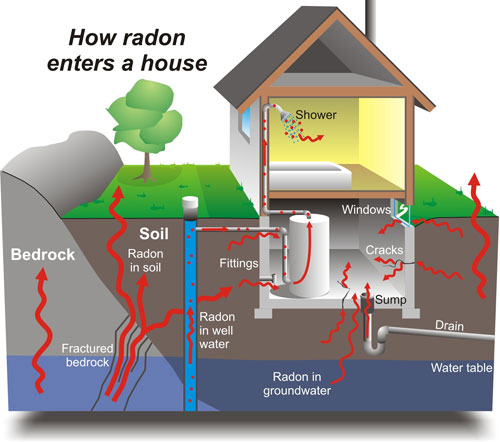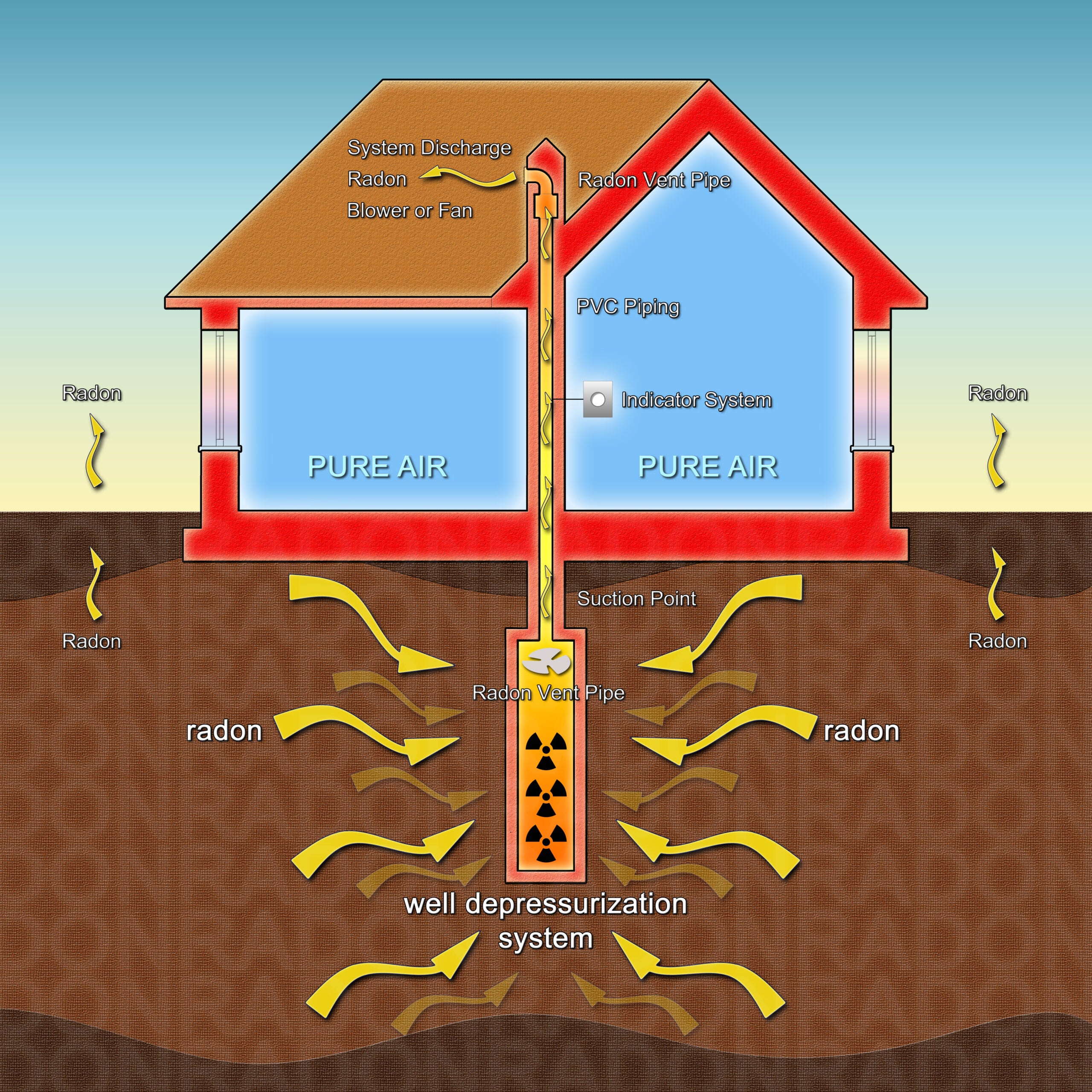Table of Contents
Radon is a radioactive gas linked to an increased risk of lung cancer. The Environmental Protection Agency (EPA) estimates that one in 15 homes has elevated radon levels, making this a serious issue for homeowners. Radon mitigation is how homeowners can address and reduce radon levels.
Radon is a radioactive gas that occurs naturally in the environment and can be found in soil, rocks, and water. Radon can seep into buildings and homes through cracks and openings in the foundation, and once it enters a building, it can become trapped and accumulate to dangerous levels.

In the United States, radon is present in varying levels in soil across the country, and some areas have higher concentrations than others. Certain building materials, such as concrete and bricks, can also contain small amounts of radon.
As a result, radon can enter homes and buildings through cracks in the foundation, gaps around pipes and cables, and other openings. Once radon enters a building, it can accumulate to dangerous levels and pose a risk to the health of the occupants.
To reduce the risk of radon exposure, it is recommended that homeowners test their homes for radon and take steps to mitigate the levels if they are found to be too high. This can include sealing cracks and gaps in the foundation, installing ventilation systems, and other measures.
Does Homeowners Insurance Cover Radon Mitigation?
Typical homeowners’ insurance policies do not cover radon mitigation. Usually, insurance does not pay for radon damages, mitigation costs, or health-related effects because it is an unforeseeable event and does not happen as an accident. However, special rare insurance packages may offer Radon coverage.
Most traditional home insurance policies do not cover the costs associated with radon testing or mitigation. However, some home insurance companies may offer additional riders or specialty endorsements to your policy that can provide coverage for these types of risks. So, if you live in an area where radon levels are known to be high, it might be worth looking into whether you can add this coverage to your existing policy.
When it comes to mitigating radon in your home, several strategies are available depending on the severity of the problem and the specific features of your property. For example, sealing cracks and openings near foundations, sump pits, and drains can help reduce infiltration from outside sources. In addition, installing a ventilation system will draw air from below the foundation slab and exhaust it safely. If installed correctly, these systems can significantly reduce indoor radon concentrations over time.
Radon testing and mitigation
Radon testing and remediation in houses typically involve several steps to determine if the home has elevated levels of radon gas and to reduce the levels to a safe concentration. Here are the general steps involved in radon testing and remediation in houses:
Radon Testing:
- Testing Kit: Purchase a radon testing kit from a reputable provider. These kits typically come with instructions on how to conduct the test.
- Placement of Testing Kit: Place the testing kit in the lowest level of the frequently occupied home, such as a basement or living room. The equipment should remain in place for the recommended time, usually between two to seven days.
- Lab Results: After the testing period has ended, send the kit to a certified lab for analysis. The lab will provide a report that indicates the level of radon gas in the home.

Radon mitigation in homes typically involves several steps to reduce the level of radon gas in the indoor air to a safe level. The process can vary depending on the specific situation, but the following are the general steps involved in radon mitigation in homes:
- Radon testing: The first step in radon mitigation is to test the home to determine the level of radon gas present. This can be done with a do-it-yourself kit or by hiring a professional radon testing service.
- Design a mitigation system: Once the radon level has been determined, a qualified radon mitigation contractor will design a mitigation system specific to the home’s neehome’se design and will consider factors such as the home’s fouhome’sn, the location of the radon entry points, and the home’s layhome’snstallation of a radon mitigation system: The installation process typically involves creating a suction point, usually in the basement or crawl space, and installing a pipe that runs up the side of the home and vents the radon gas above the roofline. The system may also include a fan to help draw the radon gas out of the soil and away from home.
- Sealing cracks and gaps: In some cases, sealing cracks and gaps in the foundation or walls may be necessary to prevent radon gas from entering the home. This can be done with caulking or other sealants.
- Post-mitigation testing: After installing the system, it’s essential to test the home again to ensure the radon levels have been successfully reduced to safe levels.
- Ongoing maintenance: The radon mitigation system requires regular maintenance and inspections to ensure it continues functioning properly and effectively.
If you already have a tested level of elevated radon in your home, you’d likely need to look into hiring a professional contractor specializing in remediation services. These professionals use sub-slab depressurization systems and active soil depressurization systems – designed to draw air from beneath the foundation slab through underground pipes and exhaust it away from your home – and other methods like sealing cracks or patching holes where air could infiltrate from outside sources. While these methods may not eliminate all radiation from your home, they can reduce indoor concentrations substantially over time; however, these services don’t typically require significant upfront investment without any assurance of success or long-term results.
Radon Insurance Coverage Example
Radon mitigation insurance coverage may work as follows:
- Coverage limits: The insurance policy will specify the coverage limits for radon mitigation. This means that the insurance company will pay up to a certain amount to mitigate radon in the home.
- Deductible: The policy may also include a deductible, which is the amount the insured is responsible for paying out of pocket before the insurance company begins to cover expenses.
- Covered expenses: Radon mitigation insurance coverage may cover costs related to testing, designing, and installing a mitigation system and post-mitigation testing.
- Exclusions: Some insurance policies may exclude coverage for certain expenses, such as repairing or replacing damaged building materials caused by the radon mitigation process.
- Percentage of coverage: The insurance company may cover a particular portion of the expenses, and the insured will be responsible for paying the remaining share. For example, the insurance company may cover 80% of the radon mitigation cost, while the insured is responsible for the remaining 20%.
So, suppose you’re worried about potential exposure to radiation due to high levels of radon gas in your home. In that case, you should consider adding additional coverage under your homeowner’s policy (if available). Doing so might protect against some of the financial costs associated with addressing a potentially dangerous situation like elevated levels of radon gases inside your residence, giving you peace of mind knowing that if anything goes wrong during the process, you won’t be won’t be won’t be won’t be won’t with expensive bills out-of-pocket!
